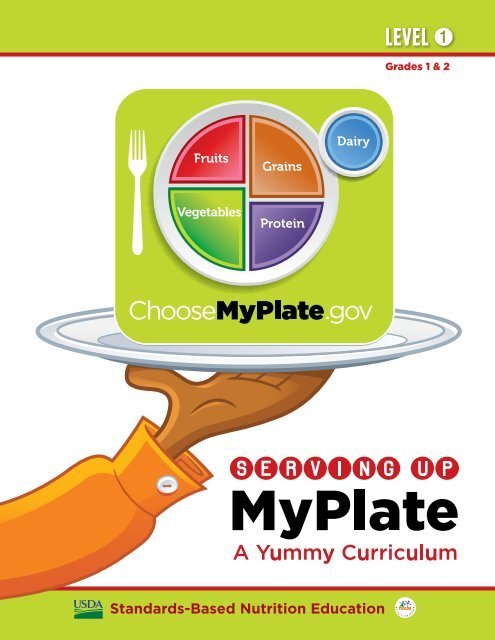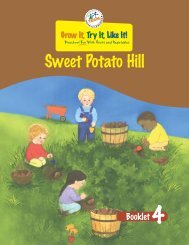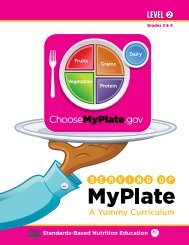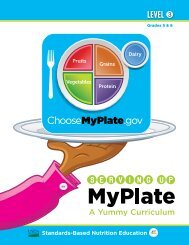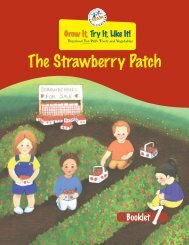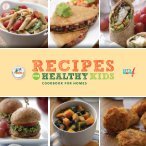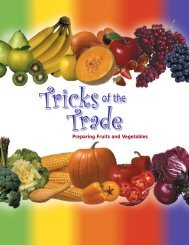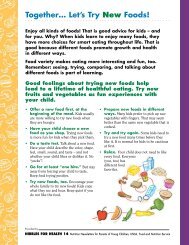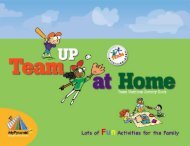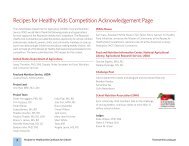Serving Up MyPlate-A Yummy Curriculum, Level 1 - Team Nutrition ...
Serving Up MyPlate-A Yummy Curriculum, Level 1 - Team Nutrition ...
Serving Up MyPlate-A Yummy Curriculum, Level 1 - Team Nutrition ...
You also want an ePaper? Increase the reach of your titles
YUMPU automatically turns print PDFs into web optimized ePapers that Google loves.
Standards-Based <strong>Nutrition</strong> Education<br />
Grades 1 & 2
Fruits:<br />
Fuel <strong>Up</strong> With<br />
Fruits at Meals<br />
or Snacks<br />
Pears, watermelon,<br />
plums, raisins,<br />
berries, and<br />
applesauce<br />
(without extra<br />
sugar) are just a few<br />
of the great choices.<br />
Make sure your fruit<br />
juice is 100% juice.<br />
raisins<br />
Keep on Moving!<br />
SERVING UP <strong>MyPlate</strong><br />
Vegetables:<br />
Color Your Plate<br />
With Great-<br />
Tasting Veggies<br />
Try to eat more<br />
dark-green, red, and<br />
orange vegetables,<br />
and beans and peas.<br />
Kids need at least 60 minutes of<br />
physical activity every day. Whether<br />
that’s running, biking, tossing a ball, or<br />
playing tag, every little bit counts.<br />
So, run around at recess, jump rope<br />
with friends, ride your scooter,<br />
or play a sport. It all adds up!<br />
Grains:<br />
Make at Least<br />
Half Your Grains<br />
Whole Grains<br />
Choose wholegrain<br />
foods, such as<br />
whole-wheat bread,<br />
oatmeal, wholewheat<br />
tortillas,<br />
brown rice, and<br />
popcorn,<br />
more often.<br />
Protein:<br />
Vary Your<br />
Protein Foods<br />
Try fish, shellfish,<br />
beans, and peas<br />
more often. Some<br />
tasty ways include<br />
a bean burrito,<br />
hummus, veggie<br />
chili, fish taco,<br />
shrimp stir-fry, or<br />
grilled salmon.<br />
Dairy:<br />
Get Your<br />
Calcium-Rich<br />
Foods<br />
Choose fat-free<br />
or low-fat milk,<br />
yogurt, and cheese<br />
at meals or snacks.<br />
Dairy foods contain<br />
calcium for strong<br />
bones and healthy<br />
teeth.<br />
Know Your “Sometimes” Foods<br />
Look out for foods with added sugars or solid<br />
fats, such as candy, cake, cookies, chips, ice<br />
cream, soda, fruit punch, lemonade, hot dogs,<br />
and bacon. They fill you up so that you don’t<br />
have room for the foods that help you<br />
eat smart and play hard. Enjoy these<br />
every once in a while, not every day.<br />
<strong>Serving</strong> <strong>Up</strong> <strong>MyPlate</strong> — Grades 1 & 2 http://teamnutrition.usda.gov<br />
U.S. Department of Agriculture • Food and <strong>Nutrition</strong> Service • September 2012 • FNS-444<br />
2
LETTER TO<br />
Dear Teacher,<br />
What are healthy food choices? What is a balanced<br />
diet? The U.S. Department of Agriculture’s Food and<br />
<strong>Nutrition</strong> Service is providing these lessons under<br />
its <strong>Team</strong> <strong>Nutrition</strong> initiative in order to help teachers<br />
integrate nutrition education into Math, Science, English<br />
Language Arts, and Health. This yummy curriculum<br />
introduces the importance of eating from all five food<br />
groups using the new <strong>MyPlate</strong> icon and a variety<br />
of hands–on activities. Students will also learn the<br />
importance of physical activity to staying healthy.<br />
In this Teacher’s Guide, you’ll find three inquiry–driven<br />
lessons that help 1st and 2nd grade children discover<br />
nutrition, explain their understandings, and reflect upon<br />
their experiences — all of which encourage a lasting<br />
awareness of what it means to be healthy. In addition<br />
to subject-driven learning, each lesson offers valuable<br />
and easy-to-implement cafeteria activities and home<br />
connections. We encourage you to include these in your<br />
planning, as they will provide your students with further<br />
practice and real-world experience. Let parents know<br />
what their children will be learning about in class so<br />
they can support these new skills at home.<br />
You will also find:<br />
• A Pacing Guide: time required per activity and<br />
recommended pacing to help you plan each lesson<br />
• Teacher’s Morsels: helpful resources, background,<br />
and tips<br />
• Extra Helpings: ideas on how to extend the<br />
learning beyond the lesson<br />
• Savor the Learning: valuable ways to connect<br />
the learning to the school cafeteria and/or<br />
students’ homes to provide real-world practice<br />
• Student Handouts: easily reproducible<br />
handouts designed to appeal to students<br />
while reinforcing lesson objectives<br />
United States Department of Agriculture<br />
Food and <strong>Nutrition</strong> Service • FNS-444<br />
September 2012<br />
Teachers<br />
• Three Original Songs: Alive With 5 Food Groups and<br />
Do/Be help students learn about healthy choices in an<br />
engaging and memorable way and are incorporated<br />
into the lessons. Dancing and singing along to an<br />
additional song called Do Your Body Right may<br />
be a fun extension activity in the third lesson. We<br />
invite you to listen to it ahead of time to determine<br />
whether your class would enjoy it. All of the songs are<br />
provided on the enclosed CD, along with the lyrics,<br />
and may be downloaded at http://teamnutrition.<br />
usda.gov/myplate.html.<br />
• Eat Smart To Play Hard With <strong>MyPlate</strong> Poster: a twosided<br />
poster showing the <strong>MyPlate</strong> icon and foods<br />
in the five food groups. The blank <strong>MyPlate</strong> on the<br />
reverse can be used as a tool to assess students’<br />
understanding.<br />
• <strong>MyPlate</strong> at Home: a colorful handout to share with<br />
parents that reinforces the lesson at home. It’s also<br />
available in Spanish. Additional copies are free for<br />
schools at http://teamnutrition.usda.gov/myplate.html.<br />
We hope you and your students enjoy the process of<br />
learning how to make healthy choices. It’s an education<br />
that will last a lifetime!<br />
Sincerely,<br />
Your Friends at <strong>Team</strong> <strong>Nutrition</strong><br />
The U.S. Department of Agriculture (USDA) prohibits discrimination in all of its programs and activities on the basis of race, color, national origin, age, disability, and where applicable, sex (including gender identity and<br />
expression), marital status, familial status, parental status, religion, sexual orientation, political beliefs, genetic information, reprisal, or because all or part of an individual's income is derived from any public assistance program.<br />
(Not all prohibited bases apply to all programs.) Persons with disabilities who require alternative means for communication of program information (Braille, large print, audiotape, etc.) should contact USDA's TARGET Center at<br />
(202) 720-2600 (voice and TDD).<br />
To file a complaint of discrimination, write to USDA, Assistant Secretary for Civil Rights, Office of the Assistant Secretary for Civil Rights, 1400 Independence Avenue, S.W., Stop 9410, Washington, DC 20250-9410; or call toll-free at<br />
(866) 632-9992 (English) or (800) 877-8339 (TDD) or (866) 377-8642 (English Federal-relay) or (800) 845-6136 (Spanish Federal-relay). USDA is an equal opportunity provider and employer.
TABLE OF<br />
Lesson Title<br />
First Course:<br />
Fun With<br />
Food Groups<br />
Time Required:<br />
Session 1 (50 minutes)<br />
Session 2 (30 minutes)<br />
Session 3 (30 minutes)<br />
Second<br />
Course:<br />
Eat Smart To<br />
Play Hard<br />
Time Required:<br />
Session 1 (30 minutes)<br />
Session 2 (40 minutes)<br />
Session 3 (40 minutes)<br />
Third Course:<br />
“Sometimes”<br />
Foods and<br />
“Switcheroos”<br />
Time Required:<br />
Session 1 (50 minutes)<br />
Session 2 (30 minutes)<br />
Session 3 (40 minutes)<br />
Essential<br />
Question<br />
What does it<br />
mean to be<br />
healthy? Eat<br />
healthy?<br />
Why is it<br />
important to<br />
eat a variety of<br />
foods from all<br />
food groups?<br />
What foods<br />
should I eat<br />
less of, and<br />
why?<br />
Contents<br />
Learning Objectives Student Handouts<br />
Students will be able to…<br />
• Identify the five food groups, and give<br />
examples of foods in each.<br />
• Explain how <strong>MyPlate</strong> serves as a<br />
reminder to eat foods from each<br />
food group.<br />
• Create a healthy meal containing a food<br />
from each food group.<br />
Students will be able to…<br />
• Identify what foods to eat more of, and<br />
explain why.<br />
• Name at least two reasons why it is<br />
important to eat foods from all five food<br />
groups for a healthy diet.<br />
• Explain that foods have nutrients that help<br />
us grow and stay healthy.<br />
• Discuss how being physically active is part<br />
of a healthy lifestyle.<br />
Students will be able to…<br />
• Identify foods with added sugars and<br />
solid fats.<br />
• Explain why foods with added sugars and<br />
solid fats should be eaten only some of<br />
the time.<br />
• Give examples of healthier food options to<br />
choose instead.<br />
1. My Food Card<br />
2. My Menu Planner<br />
1. A Day in the<br />
Life of...<br />
2. <strong>Serving</strong> <strong>MyPlate</strong><br />
to MyFamily<br />
1. “Sometimes” Foods<br />
and “Switcheroos”<br />
2. “Switcheroo”<br />
Recipe<br />
<strong>Serving</strong> <strong>Up</strong> <strong>MyPlate</strong> — Grades 1 & 2 http://teamnutrition.usda.gov<br />
U.S. Department of Agriculture • Food and <strong>Nutrition</strong> Service • September 2012 • FNS-444<br />
4
TABLE OF<br />
Lesson Title Standards Met*<br />
First Course:<br />
Fun With Food<br />
Groups<br />
Second Course:<br />
Eat Smart To<br />
Play Hard<br />
Third Course:<br />
“Sometimes”<br />
Foods and<br />
“Switcheroos”<br />
Contents<br />
English Language Arts: Speaking and Listening Standards: Comprehension and<br />
Collaboration (1.1, 2.1): Participate in collaborative conversations with diverse<br />
partners; Reading Standards: Foundational Skills/Fluency (1.4, 2.4): Read with<br />
sufficient fluency to support comprehension.<br />
Science: Standard (A): Science as an inquiry: Understandings about Scientific<br />
Inquiry.<br />
Health: Standard (1.2.1): Identify that healthy behaviors impact personal health.<br />
Math: Number and Operations in Base Ten (1, 2): Use place value understanding<br />
and properties of operations to add and subtract.<br />
English Language Arts: Speaking and Listening Standards: Comprehension and<br />
Collaboration (1.1, 2.1): Participate in collaborative conversations with diverse<br />
partners; Writing Standards: Production and Distribution of Writing (1.4, 2.4):<br />
Read with sufficient fluency to support comprehension.<br />
Science: Standard (F): Science in personal and social perspective: Personal<br />
Health.<br />
Health: Standard (1.2.1): Identify that healthy behaviors impact personal health.<br />
Math: Number and Operations in Base Ten (1, 2): Use place value understanding<br />
and properties of operations to add and subtract.<br />
English Language Arts: Reading Standards: Foundational Skills (1.4, 2.4): Read<br />
with sufficient accuracy and fluency to support comprehension. Speaking and<br />
Listening Standards: Comprehension and Collaboration (1.1, 2.1): Participate in<br />
collaborative conversations with diverse partners; (1.4, 2.4): Describe people,<br />
places, things, and events with relevant details, expressing ideas and feelings<br />
clearly; Writing Standards: Text Types and Purposes (1.2, 2.2): Write informative/<br />
explanatory texts in which they name a topic, supply some facts about the topic,<br />
and provide some sense of closure.<br />
Science: Standard (A): Science as an inquiry: Understandings about Scientific<br />
Inquiry; Standard (F): Science in personal and social perspective: Personal Health.<br />
Health: Standard (5.2.1): Identify situations when a health-related decision<br />
is needed; Standard (5.2.1): List healthy options to health-related issues or<br />
problems. Standard (5.8.6): Choose a healthy option when making a decision.<br />
Math: Measurement and Data (1, 2): Represent and interpret data; Number and<br />
Operations in Base Ten (1, 2): Use place value understanding and properties of<br />
operations to add and subtract.<br />
*Sources: English Language Arts and Math standards — Common Core; Science education standards — National Academy of Sciences; Health standards — American Cancer Society<br />
<strong>Serving</strong> <strong>Up</strong> <strong>MyPlate</strong> — Grades 1 & 2 http://teamnutrition.usda.gov<br />
U.S. Department of Agriculture • Food and <strong>Nutrition</strong> Service • September 2012 • FNS-444<br />
5
Original Songs LYRICS<br />
Alive With 5 Food Groups<br />
(Talking about the five food groups, what they are<br />
and what they help do)<br />
Banana is a fruit, broccoli is a veggie<br />
Rice is a grain, chicken is a protein food<br />
Milk is dairy, and now we’ve got five<br />
We’re going to feel our best (uh huh), we’re going to feel alive!<br />
Chorus:<br />
Alive, with five, both you and I<br />
Alive with five, let’s give them a try<br />
Fruits and vegetables, dairy and grains<br />
Add to that a protein food and you’ll be on your way!<br />
So many fruits and vegetables are good for me<br />
Some help me heal my wounds, or give me more energy<br />
Sometimes I like to eat them with some meat, bread, and cheese<br />
These five food groups give me what I need, wouldn’t you agree?<br />
Chorus<br />
I’ve got a red apple (a fruit, a fruit)<br />
And green spinach leaves (a vegetable, a vegetable)<br />
I toasted up some bread (a grain, a grain)<br />
With some low-fat cheddar cheese (that’s dairy, that’s dairy)<br />
A few slices of turkey (a protein food, a protein food)<br />
That’s a fine-looking plate (my plate, my plate)<br />
If you want to be healthy, if you want to feel your best<br />
These five food groups are the key to your success!<br />
Chorus<br />
Do/Be<br />
Chorus:<br />
Nutrients are good for me<br />
Some help me do and some help me be<br />
Some help me run and jump and grow<br />
Others keep me feeling like a pro<br />
Nutrients are good for me<br />
Some help me do and some help me be<br />
Working all together to keep me healthy<br />
Those five food groups we learned about<br />
They’ve got nutrients we need<br />
To do things at our peak<br />
To be more healthy<br />
Some help give our skin a healthy glow<br />
Some help keep us from catching colds<br />
And others strengthen bones and muscles<br />
So round those bases we can hustle<br />
Chorus<br />
That candy, cookies, soda, ice cream<br />
Sometimes we eat too much<br />
They don’t have as many nutrients<br />
No, they don’t have quite the touch<br />
So, how about we substitute<br />
The sweet stuff with a piece of fruit<br />
Because fruit’s got the stuff we’re talking about<br />
So many nutrients — there is no doubt<br />
Chorus<br />
<strong>Serving</strong> <strong>Up</strong> <strong>MyPlate</strong> — Grades 1 & 2 http://teamnutrition.usda.gov<br />
U.S. Department of Agriculture • Food and <strong>Nutrition</strong> Service • September 2012 • FNS-444<br />
6
SERVING UP<br />
First<br />
Main Ingredients<br />
Recommended Pacing:<br />
Session 1 (50 minutes) — First Taste,<br />
Digging In (Part A)<br />
Session 2 (30 minutes) — Digging In (Part B)<br />
Session 3 (30 minutes) — Digesting It All<br />
Essential Question:<br />
What does it mean to be healthy? Eat<br />
healthy?<br />
Learning Objectives:<br />
Students will be able to…<br />
• Identify the five food groups, and give<br />
examples of foods in each.<br />
• Explain how <strong>MyPlate</strong> serves as a<br />
reminder to eat foods from each food<br />
group.<br />
• Create a healthy meal containing a<br />
food from each food group.<br />
Subject Connections:<br />
English Language Arts, Science, Health,<br />
Math<br />
Materials & Preparation:<br />
• One sign per food group (post in<br />
different visible areas of classroom)<br />
• Colored pencils, crayons, or markers;<br />
scissors, glue<br />
• Images of food: magazines, newspaper,<br />
or circular ads<br />
• Computer, CD or MP3 player with<br />
speakers<br />
• Original Song & Lyrics:<br />
Alive With 5 Food Groups<br />
• Student Reproducible 1:<br />
My Food Card (3 per student;<br />
reproduce on card stock if possible)<br />
• Student Reproducible 2:<br />
My Menu Planner<br />
• Eat Smart To Play Hard With <strong>MyPlate</strong><br />
Poster (display in your classroom)<br />
• <strong>MyPlate</strong> at Home parent handouts<br />
COURSE LESSON 1 FOR GRADES 1 & 2<br />
Fun With Food Groups<br />
What’s Cooking?<br />
Learning to make healthy food choices is something children will use<br />
for life. Lesson 1 introduces students to the five food groups, while also<br />
meeting English Language Arts, Science, Math, and Health standards<br />
through a variety of fun and interactive activities.<br />
FIRST TASTE: Engage (20 minutes)<br />
1. Begin by asking<br />
students to think about<br />
the Essential Question:<br />
What do they think it<br />
means to be healthy?<br />
What do they think it<br />
means to eat healthy?<br />
Accept all answers and<br />
list them on the board.<br />
Explain to students<br />
that to be healthy one<br />
should eat healthy and<br />
be physically active<br />
each day.<br />
2. Play the song Alive With<br />
5 Food Groups for the<br />
class. Ask children to<br />
listen carefully to the<br />
lyrics of the song. The<br />
lyrics introduce the<br />
five food groups. Invite<br />
students to share what<br />
they learned from the song. Can anyone identify the five food groups?<br />
(Fruits, Vegetables, Protein, Grains, Dairy). Note: You may want to play<br />
the song more than once.<br />
3. Display the <strong>MyPlate</strong> poster. Ask students to share what they notice<br />
about the <strong>MyPlate</strong> icon. Explain that <strong>MyPlate</strong> illustrates the five food<br />
groups a person should eat each day, and that the colors red, green,<br />
orange, blue, and purple represent the five food groups. Before they<br />
eat, people should think about what goes on their plate or in their cup.<br />
Foods like vegetables, fruits, whole grains, low-fat dairy products, and<br />
lean protein help them eat healthy and be healthy.<br />
<strong>Serving</strong> <strong>Up</strong> <strong>MyPlate</strong> — Grades 1 & 2<br />
U.S. Department of Agriculture • Food and <strong>Nutrition</strong> Service • September 2012 • FNS-444<br />
http://teamnutrition.usda.gov<br />
7
DIGGING IN: Explore (60 minutes)<br />
Part A (30 minutes)<br />
4. List the names of all five food groups on the board.<br />
Explain that foods are put into groups to help us<br />
understand how to create a balanced meal. Ask the<br />
class why they think eating foods from each food<br />
group is important. Putting food from each food<br />
group on our plate helps us eat smart to play hard.<br />
5. Invite students to share a food. Encourage them to<br />
think about foods they have eaten at home or in<br />
the cafeteria, or seen their parents purchase in the<br />
supermarket. Prompt them by asking them to think<br />
of foods they’ve seen that grow in the ground or on<br />
trees or plants, are found in the sea, or come from<br />
an animal. Write down their answers on the board.<br />
6. Work together as a class to determine what<br />
food group each belongs to. If students suggest<br />
a combination food or dish (for example: pizza,<br />
sandwich, curry, or tacos), help students to break<br />
the meal down by asking them to think about its<br />
specific main food ingredients. For example:<br />
Tacos — tortilla (Grain Group), tomatoes and lettuce<br />
(Vegetable Group), cheese (Dairy Group), ground<br />
turkey or beef (Protein Foods Group).<br />
Beef or Turkey<br />
Protein Foods Group<br />
Lettuce<br />
Vegetable Group<br />
Cheese<br />
Dairy Group<br />
Tomatoes<br />
Vegetable Group<br />
Tortilla<br />
Grain Group<br />
TEACHER’S<br />
Morsel<br />
7. Next, supply each student with art supplies and three<br />
My Food Card handouts. Note: If you have more time,<br />
ask students to create five Food Cards, one from<br />
each group. Give students 15 minutes to complete<br />
their Food Cards — each with a drawing or collage<br />
of a favorite food from a different food group. Ask<br />
students to draw one specific food, such as a fruit or<br />
a dairy product, as opposed to combination foods,<br />
such as pizza or tacos. Prompt students to think<br />
of foods they like to eat by asking what they ate at<br />
lunch that day, or dinner the night before. They will<br />
also need to complete the sentences on the card<br />
according to what food they chose.<br />
8. Invite students to share and read their Food Cards<br />
aloud with the class and explain why they like each<br />
food item. Collect everyone’s cards.<br />
Part B (30 minutes*)<br />
9. Share with students that they will now play a<br />
game called Musical Food Groups (similar to<br />
“musical chairs,” but uncompetitive). In preparation,<br />
designate five different sections of the classroom by<br />
clearly labeling each as one of the five food groups.<br />
You will be using the song Alive With 5 Food Groups<br />
for this game.<br />
The objective of the game is to be able to identify<br />
foods in their correct food groups. Shuffle the Food<br />
<strong>Serving</strong> <strong>Up</strong> <strong>MyPlate</strong> — Grades 1 & 2 http://teamnutrition.usda.gov<br />
U.S. Department of Agriculture • Food and <strong>Nutrition</strong> Service • September 2012 • FNS-444<br />
8
Cards and explain that each student will draw one<br />
card from the deck. When the music starts, students<br />
will move around the room. When the music stops,<br />
students should move to the food group to which<br />
their Food Card belongs. For example, a student<br />
with a pineapple on his or her Food Card should<br />
stand in the Fruit Group section.<br />
10. Play at least two rounds to help students become<br />
familiar with the food groups. After each round,<br />
collect all cards, shuffle, and have students select a<br />
new card. Encourage students to dance or express<br />
themselves through physical activity while the music<br />
is playing.<br />
11. In the third and final round of the game, add a new<br />
objective. Students will need to organize themselves<br />
into healthy “meals” based on <strong>MyPlate</strong> (groups of<br />
five students representing all food groups). For<br />
example, if a student’s card is broccoli, he/she<br />
represents the Vegetable Group. When the music<br />
stops, he/she will need to find four other students,<br />
one from each food group, to create their “meal.”<br />
Write the foods in each meal on the board.<br />
Note: In the event that your class cannot be divided<br />
perfectly into groups of five, ask the students who<br />
have fewer than five foods in their group to think of the<br />
remaining foods in their “meal.”<br />
12. Once all students have organized themselves into<br />
meals, ask each group to share the foods in their<br />
“meal.” Write these on the board. Ask students,<br />
“What sounds yummy? What would you eat for<br />
breakfast, lunch, or dinner?” Ask students if there is<br />
any rearranging they can do as a class to make the<br />
meals tastier. Are there any ideas of ways to make<br />
substitutions so the meals are healthier? Explain<br />
to students that they may not be able to get every<br />
food group in one meal, but if they ate a protein<br />
food, dairy, fruit, and grain for breakfast, they could<br />
have a vegetable later for a snack.<br />
DIGESTING IT All: Explain, Evaluate<br />
(30 minutes)<br />
TEACHER’S<br />
Morsel<br />
13. Ask students the Essential Question again: “What<br />
does it mean to be healthy? Eat healthy?” Allow<br />
time for students to answer the question. (Making<br />
healthy food choices means eating foods each day<br />
from the five food groups.)<br />
14. Next, distribute the Menu Planner handout. Ask<br />
students to work in pairs to create 1 week’s worth of<br />
dinners based on <strong>MyPlate</strong>. They may use the meals<br />
they created in the game (written on the board) as a<br />
guide, but they may also substitute other foods as<br />
long as they create a meal with foods from all five<br />
food groups. Once it is completed, students may<br />
take the My Menu Planner home to share and try<br />
with their families.<br />
9<br />
<strong>Serving</strong> <strong>Up</strong> <strong>MyPlate</strong> — Grades 1 & 2 http://teamnutrition.usda.gov<br />
U.S. Department of Agriculture • Food and <strong>Nutrition</strong> Service • September 2012 • FNS-444
SAVOR THE LEARNING:<br />
Elaborate<br />
Cafeteria:<br />
• Analyze the menus from the school cafeteria for<br />
1 week. Identify what foods belong to which food<br />
groups.<br />
At Home:<br />
• Have students take home the <strong>MyPlate</strong> at Home parent<br />
handout and the My Menu Planner reproducible they<br />
completed in class. Encourage students to talk about<br />
their menus with their families.<br />
• Ask students to draw a picture of what they ate for<br />
dinner at home, and then compare it to the <strong>MyPlate</strong> icon.<br />
FOOD FOR<br />
Thought<br />
• Some people say that tomatoes are a fruit. That is<br />
because tomatoes come from the fruit part of the<br />
tomato plant. But we eat them like a vegetable. So<br />
they belong in the Vegetable Group.<br />
• Beans are special! They are both a vegetable<br />
and a protein food. Black beans, chickpeas/<br />
garbanzo beans, pinto beans, and navy<br />
beans…try them all!<br />
EXTRA HELPINGS: Elaborate<br />
(1 week, 10 minutes per day)<br />
Track Your Fruits and Vegetables! Wondering<br />
how many different kinds of fruits and veggies you<br />
eat as a class? Find out by tracking the fruit and<br />
vegetable consumption of all students in your class<br />
in a week. Help your students create a chart on a<br />
poster board labeled Let’s All Root...For Veggies<br />
and Fruit. The chart should list the days of the week<br />
across the top. The names of the students should be<br />
listed in a column going down the left. For a week,<br />
invite students to write the names of the fruits and<br />
vegetables they have eaten each day for breakfast<br />
and/or lunch (depending on time of class). At the<br />
end of the week, have students count up how many<br />
fruits/vegetables they each ate. Then have them<br />
calculate which fruit/vegetable was the most popular<br />
in the whole class. Publish the results on a bulletin<br />
board or in the school cafeteria. Get the whole<br />
school involved; challenge other classes to see who<br />
can eat the widest variety of fruits and vegetables.<br />
Offer suggestions for trying new foods. For instance,<br />
if you like French fries, try sweet potato fries. If you<br />
like lettuce on your sandwich, try baby spinach. Keep<br />
tracking for a month to see long-term results and<br />
improvement!<br />
10<br />
<strong>Serving</strong> <strong>Up</strong> <strong>MyPlate</strong> — Grades 1 & 2 http://teamnutrition.usda.gov<br />
U.S. Department of Agriculture • Food and <strong>Nutrition</strong> Service • September 2012 • FNS-444
MY<br />
Food Card<br />
Name: Date:<br />
Fill in the sentences below, then draw a picture or make a collage of your favorite food item.<br />
I like to eat ,<br />
<strong>Serving</strong> <strong>Up</strong> <strong>MyPlate</strong> — Grades 1 & 2<br />
U.S. Department of Agriculture • Food and <strong>Nutrition</strong> Service • September 2012 • FNS-444<br />
(My favorite food)<br />
which is part of the ,<br />
(Food group)<br />
at .<br />
(Mealtime)<br />
I like to eat it with ,<br />
(Other food items)<br />
because .<br />
fat free<br />
(Explain why you like to eat it)<br />
FIRST COURSE • REPRODUCIBLE 1<br />
http://teamnutrition.usda.gov
My Menu<br />
MONDAY TUESDAY WEDNESDAY THURSDAY FRIDAY<br />
Fruits: Fruits: Fruits: Fruits: Fruits:<br />
Vegetables: Vegetables: Vegetables: Vegetables: Vegetables:<br />
Protein: Protein: Protein: Protein: Protein:<br />
Grains: Grains: Grains: Grains: Grains:<br />
Dairy: Dairy: Dairy: Dairy: Dairy:<br />
<strong>Serving</strong> <strong>Up</strong> <strong>MyPlate</strong> — Grades 1 & 2<br />
U.S. Department of Agriculture • Food and <strong>Nutrition</strong> Service • September 2012 • FNS-444<br />
PLANNER FIRST COURSE • REPRODUCIBLE 2<br />
Name:_________________________________ Date:_________________________<br />
Plan your dinner menu for a week. Work with a partner to make a full, balanced, and healthy<br />
meal for each day. Remember to make sure each meal has one food item from each of the<br />
five food groups. You may use one of the food groups for a drink.<br />
When finished, bring it home to share, and try the meals with your family!<br />
http://teamnutrition.usda.gov<br />
fat free
SERVING UP <strong>MyPlate</strong><br />
Second COURSE <strong>MyPlate</strong> LESSON 2 FOR GRADES 1 & 2<br />
Main Ingredients<br />
Recommended Pacing:<br />
Session 1 (30 minutes) — First Taste<br />
Session 2 (40 minutes) — Digging In<br />
Session 3 (40 minutes) — Digesting It All<br />
Essential Question:<br />
Why is it important to eat a variety of<br />
foods from all food groups?<br />
Learning Objectives:<br />
Students will be able to...<br />
• Identify what foods to eat more of and<br />
explain why.<br />
• Name at least two reasons why it is<br />
important to eat foods from all five food<br />
groups for a healthy diet.<br />
• Explain that foods have nutrients that<br />
help us grow and stay healthy.<br />
• Discuss how that being physically<br />
active is part of a healthy lifestyle.<br />
Subject Connections:<br />
English Language Arts, Science, Health,<br />
Math<br />
Materials & Preparation:<br />
• Computer, CD or MP3 player with<br />
speakers<br />
• Various art supplies (crayons, colored<br />
pencils)<br />
• Original Song & Lyrics:<br />
Do/Be<br />
• Student Reproducible 1:<br />
A Day in the Life of…<br />
• Student Reproducible 2: <strong>Serving</strong><br />
<strong>MyPlate</strong> to MyFamily<br />
Eat Smart To Play Hard<br />
What’s Cooking?<br />
With so many different foods to choose from, it’s often hard to know what<br />
to put on our plates for a healthy diet. In this lesson, students discover how<br />
making healthy food choices and being physically active will help them<br />
grow, play, learn, and stay healthy. <strong>Curriculum</strong> standards in Math, Science,<br />
English Language Arts, and Health will be met as students engage in<br />
collaborative and hands-on learning activities.<br />
FIRST TASTE: Engage (30 minutes)<br />
1. Engage students by asking them, “What do cars, boats, and rocket<br />
ships need to keep going?” (Fuel) Next, ask, “Do people need fuel?<br />
Why?” Accept all answers. Ask students if they can remember a time<br />
when they were feeling sluggish and they didn’t have any energy. What<br />
did it feel like? What made them feel better?<br />
2. If students don’t mention food, ask them, “Why do we eat?” Explain<br />
that food gives us energy, or “fuel,” for all sorts of activities — from<br />
running, playing ball, thinking, and talking, to something as simple as<br />
blinking our eyes.<br />
3. Explain that it is important for all of us to move each day to be healthy.<br />
Ask students to think of physical activities they enjoy, like riding bikes<br />
or jumping rope. How do students feel after they have been physically<br />
active? How is physical activity good for their bodies? Accept all<br />
answers and list them on the board.<br />
4. Ask students to think about how they can be more active.<br />
How can they inspire each other, friends, and family?<br />
As a class, create an Eat Smart To Play Hard tip<br />
poster. Choose 10 activities, along with helpful tips,<br />
to inspire everyone to move more each week. (For<br />
example: jump rope, dance to your favorite song,<br />
walk your dog.) Provide students with paper and<br />
art materials and ask them to draw healthy<br />
foods to illustrate the “eat smart” part of<br />
the message. For example, students could<br />
show fruits, vegetables, low-fat milk and<br />
yogurt, whole grains, and lean proteins.<br />
Encourage students to be creative in<br />
how they convey their food and activity<br />
message, such as showing a kid biking<br />
up a rainbow of fruits and vegetables, or<br />
tossing a <strong>MyPlate</strong> frisbee.<br />
<strong>Serving</strong> <strong>Up</strong> <strong>MyPlate</strong> — Grades 1 & 2<br />
U.S. Department of Agriculture • Food and <strong>Nutrition</strong> Service • September 2012 • FNS-444<br />
http://teamnutrition.usda.gov<br />
13
DIGGING IN: Explore<br />
(40 minutes)<br />
5. Write the word nutrient on the board.<br />
Ask if anyone knows what a nutrient is.<br />
Help students understand that a nutrient<br />
is “something found in some foods that<br />
is good for you and helps you grow and<br />
stay healthy.”<br />
6. Now ask students what they think it means<br />
to eat a nutritious food or meal. Explain<br />
to students that a nutritious food or meal<br />
provides many nutrients the body needs.<br />
7. Play the song called Do/Be and ask students to<br />
listen to it carefully. The lyrics of the song introduce<br />
the idea that different foods do different things for<br />
our bodies. Remind students that in the last lesson,<br />
they learned that we need to eat foods from each<br />
of the five food groups. That’s because each food<br />
group gives us different nutrients we need to grow,<br />
play, learn, and be healthy. When we don’t fuel up<br />
with enough of the right kinds of foods, we can’t be<br />
our best, just like a rocket ship can’t blast off and<br />
soar through space if it doesn’t have enough of the<br />
right kind of fuel.<br />
Some types of foods that many people do not get<br />
enough of are: fruits, vegetables, whole grains,<br />
low-fat milk and yogurt, and seafood. Some foods<br />
people eat too much of are: candy, cake, cookies,<br />
chips, sausages, hot dogs, and ice cream.<br />
8. After playing the song once, ask the class what<br />
the song says about eating a variety of foods. For<br />
example, some foods give us energy or “fuel,” while<br />
some foods may help us keep from getting a cold.<br />
(Nutrients help our bodies DO the things we want<br />
and need, and they help us BE healthy.)<br />
9. Play the song again and invite students to sing along.<br />
10. Next, pass out the Day in the Life of… handout.<br />
Explain to students they will write a short story<br />
called A Day in the Life of… about their favorite<br />
fruit or vegetable and what that food does to help<br />
TEACHER’S<br />
Morsel<br />
people. Alternatively, they may also choose to write<br />
a rhyming poem or song about their favorite fruit or<br />
vegetable.<br />
11. Finally, ask students to write a brief description of<br />
what their favorite fruit or vegetable looks like. Let<br />
students take turns reading their descriptions out<br />
loud and see if other students can guess what it is.<br />
If there is time, allow students to draw a picture of<br />
their favorite fruit or vegetable. Display their stories<br />
next to their drawings on a bulletin board.<br />
DIGESTING IT All: Explain, Evaluate<br />
(40 minutes)<br />
<strong>MyPlate</strong> Variety Math<br />
12. In this final activity, students will use math to practice<br />
making meals with foods from all five food groups.<br />
Have students work in pairs to answer the questions.<br />
13. Tell students that their friend Sarah needs their<br />
help. She has to prepare <strong>MyPlate</strong> meals for herself<br />
and her two cousins. They are all moderately active<br />
7-year-old girls. She is having trouble figuring out<br />
what counts. Have students answer the following<br />
word problems to help Sarah make the right<br />
decisions. Remind them to use <strong>MyPlate</strong> as a guide.<br />
<strong>Serving</strong> <strong>Up</strong> <strong>MyPlate</strong> — Grades 1 & 2 http://teamnutrition.usda.gov<br />
U.S. Department of Agriculture • Food and <strong>Nutrition</strong> Service • September 2012 • FNS-444<br />
14
I. Sarah is counting fruits that she and her cousins<br />
will need for the day. Sarah has small oranges,<br />
peaches, and bananas. She needs three pieces<br />
of fruit for each person.<br />
a. In total, how many pieces of fruit does she<br />
need for herself and her two cousins? (Nine)<br />
b. What are some ways she can divide the fruit up<br />
among meals and snacks? (Answers will vary; for<br />
example: offer one fruit at each meal —<br />
breakfast, lunch, and dinner; serve fruit at<br />
breakfast and lunch and one for a snack.)<br />
II. Sarah has two small bananas, one small orange,<br />
and two small peaches.<br />
a. How many does she have in total? (Five)<br />
b. How many more does she need? (Four)<br />
III. Sarah is trying to decide what to have for dinner<br />
in a restaurant. She has two choices. Help her<br />
choose a meal that has a variety of food from all<br />
five food groups.<br />
Meal Choice A is a turkey burger on a whole-grain<br />
bun with lettuce and tomato. It is served with<br />
baked beans and milk.<br />
a. How many food groups are part of this meal?<br />
(Four)<br />
b. How many different vegetables are part of this<br />
meal? (Three: lettuce, tomato, beans)<br />
c. How many protein foods are part of this meal?<br />
(Two: turkey burger, and the beans could also<br />
be counted as a protein food.)<br />
d. How many fruits does this meal have? (None)<br />
e. How many dairy foods does it have?<br />
(One: milk)<br />
f. Does the meal have something from the Grain<br />
Group in it? (Yes, the whole-grain bun.)<br />
g. Does this meal provide foods from all five food<br />
groups? (Not quite — it is missing a fruit.)<br />
h. What fruit could Sarah add to Choice A to<br />
help make half her plate fruits and vegetables?<br />
(Answers will vary; for example: a piece of fruit<br />
like an apple or a banana. Sarah could also<br />
have fruit as a snack later.)<br />
TEACHER’S<br />
Morsel<br />
Around the World Food Fair: Organize a Multicultural<br />
Food Fair to share and sample a variety of foods from<br />
different cultures and countries. Invite other classes<br />
and parents to participate by bringing in a favorite dish<br />
from their culture or native country. Have students<br />
create posters to display weeks before that advertise<br />
the food fair, and share information about each<br />
food group. Students can draw pictures or create<br />
collages, including the <strong>MyPlate</strong> icon, with ideas<br />
of foods from each group. Connect this<br />
activity to social studies or geography<br />
by learning about different cultures<br />
and parts of the world.<br />
whole<br />
wheat<br />
tortillas<br />
baba<br />
ghanoush<br />
edamame tostones<br />
Black<br />
bean<br />
burritos<br />
<strong>Serving</strong> <strong>Up</strong> <strong>MyPlate</strong> — Grades 1 & 2 http://teamnutrition.usda.gov<br />
U.S. Department of Agriculture • Food and <strong>Nutrition</strong> Service • September 2012 • FNS-444<br />
swiss<br />
chard<br />
salad<br />
spanakopita<br />
15
Meal Choice B is spaghetti with tomato sauce<br />
and meatballs. It comes with a garden salad.<br />
i. How many food groups are part of this meal?<br />
(Three)<br />
j. How many vegetable items does it have?<br />
(Two: tomato sauce and the salad)<br />
k. How many foods from the Protein Foods<br />
Group does it have? (One: the meatballs)<br />
l. Does Sarah’s pasta dish have foods from all<br />
five food groups? (Not quite — it is missing<br />
food from the Dairy Group and the Fruit<br />
Group.)<br />
m. What additional foods can Sarah add to<br />
Choice B so it will have all five food groups?<br />
(Answers will vary; for example: a glass of milk<br />
and a side of grapes.)<br />
IV. Sarah is choosing vegetables for her cousins’<br />
dinner. So far, she has broccoli for one dinner.<br />
She looks in the fridge to find something for<br />
another meal. This is what she finds: zucchini,<br />
tomato, cauliflower, spinach, corn, a plum, and a<br />
lemon.<br />
a. How many of the foods count as a vegetable?<br />
(Five)<br />
b. How many vegetables does she need if both<br />
of her cousins want two types of vegetables<br />
for their dinner? (Four)<br />
SAVOR THE LEARNING: Elaborate<br />
Home:<br />
• Have students write a letter to a family member<br />
encouraging him/her to eat a variety of foods,<br />
meaning different foods from each food group,<br />
using the reproducible <strong>Serving</strong> <strong>MyPlate</strong> to<br />
MyFamily.<br />
• Suggest that students try a new food at home<br />
and then report to the class about the food they<br />
tried and how they liked it. Post their new foods<br />
on the bulletin board under the title Our New Food<br />
Adventures.<br />
FOOD FOR<br />
Thought<br />
Eat smart to play hard: Eat fruits and<br />
veggies every day at meals, snacks, or for<br />
dessert. Try fruits and veggies of every color<br />
in the rainbow to give you the fuel to soar<br />
through your day like a rocket ship!<br />
• Invent your own pizza using<br />
ingredients from each food group.<br />
What would you put on it?<br />
EXTRA HELPINGS: Elaborate<br />
(30 minutes)<br />
<strong>MyPlate</strong> Variety Skits: Divide students into<br />
groups of five, so that each food group is<br />
represented. Ask them to think and talk about<br />
the Essential Question, “Why is it important to<br />
eat a variety of foods from all food groups?”<br />
Students will then work in their groups to create<br />
a short skit about how foods in their food<br />
groups contribute to healthy bodies. Tell them<br />
that their skits should express the benefits of<br />
eating specific foods in their food group. For<br />
example: (Dairy) milk and yogurt help our teeth<br />
and bones grow and stay strong. Emphasize<br />
that the foods work together to keep us healthy.<br />
Give every group a chance to perform its<br />
skit. You may want to invite other classes and<br />
parents to come view the performance so they<br />
can learn about <strong>MyPlate</strong> too!<br />
16<br />
<strong>Serving</strong> <strong>Up</strong> <strong>MyPlate</strong> — Grades 1 & 2 http://teamnutrition.usda.gov<br />
U.S. Department of Agriculture • Food and <strong>Nutrition</strong> Service • September 2012 • FNS-444
A DAY IN<br />
The Life of...<br />
Name:_________________________________ Date:__________________________<br />
What’s your favorite fruit or vegetable? Imagine what it would be like to live a day in the<br />
life of your fruit or veggie. Write a short story, poem, or song about it.<br />
Questions to think about and get you started:<br />
1. Where does it live? Where does it grow? What it would do each day?<br />
2. What it would see, hear, and feel? Where would it want to go?<br />
3. What would it want to be when it grows up?<br />
(my favorite fruit or veggie)<br />
<strong>Serving</strong> <strong>Up</strong> <strong>MyPlate</strong> — Grades 1 & 2<br />
U.S. Department of Agriculture • Food and <strong>Nutrition</strong> Service • September 2012 • FNS-444<br />
SECOND COURSE • REPRODUCIBLE 1<br />
http://teamnutrition.usda.gov
SERVING<br />
<strong>MyPlate</strong> to MyFamily<br />
Name:_________________________________Date:__________________________<br />
Write a letter to a family member explaining why it is important to eat foods from each<br />
food group. Offer ideas for a healthier meal. List the foods in your favorite meal, and<br />
draw a picture of them in the blank <strong>MyPlate</strong> below.<br />
Dear<br />
Try my favorite meal!<br />
Fruits_____________________________________<br />
Vegetables_________________________________<br />
Grains____________________________________<br />
Protein_______________________________________<br />
Dairy___________________________________________<br />
<strong>Serving</strong> <strong>Up</strong> <strong>MyPlate</strong> — Grades 1 & 2<br />
U.S. Department of Agriculture • Food and <strong>Nutrition</strong> Service • September 2012 • FNS-444<br />
SECOND COURSE • REPRODUCIBLE 2<br />
http://teamnutrition.usda.gov
SERVING UP<br />
Third COURSE LESSON 3 FOR GRADES 1 & 2<br />
Main Ingredients<br />
Recommended Pacing:<br />
Session 1 (50 minutes) — First Taste,<br />
Digging In (Part A)<br />
Session 2 (30 minutes) — Digging In (Part B)<br />
Session 3 (40 minutes) — Digesting It All<br />
Essential Question:<br />
What foods should I eat less of and why?<br />
Learning Objectives:<br />
Students will be able to...<br />
• Identify foods with added sugars and<br />
solid fats.<br />
• Explain why foods with added sugars<br />
and solid fats should be eaten only some<br />
of the time.<br />
• Give examples of healthier food options<br />
to choose instead.<br />
Subject Connections:<br />
English Language Arts, Science, Health,<br />
Math<br />
Materials & Preparation:<br />
• Water<br />
• A full bag/box of sugar cubes (cubes<br />
that are equal to 4 grams (g) or 1<br />
teaspoon (tsp) of sugar; double the<br />
amount if using cubes that equal 1 /2 tsp)<br />
• Five samples of foods and drinks<br />
(e.g., can of regular soda, cup of fatfree<br />
unflavored milk, cup of fat-free<br />
chocolate milk, cup of 100% orange<br />
juice, cup of lemonade, 2 medium<br />
chocolate chip cookies, snack-size bag<br />
microwave low-fat popcorn, apple, 2<br />
graham crackers, 1.6-oz milk chocolate<br />
candy bar, 2 Tablespoons (Tbsp) of<br />
pancake syrup)<br />
• Butter (2-Tbsp sample in a dish, per<br />
group; there are 8 tbsp per stick)<br />
• Vegetable oil (2-Tbsp sample in a dish,<br />
one per group)<br />
• Straws (clear, one per student)<br />
• Student Reproducible 1:<br />
“Sometimes” Foods and “Switcheroos”<br />
• Student Reproducible 2:<br />
“Switcheroo” Recipe<br />
“Sometimes” foods<br />
and “Switcheroos”<br />
What’s Cooking?<br />
In this lesson, students explore the concept<br />
of “sometimes” foods (foods that are higher<br />
in solid fats and added sugars), and learn<br />
that it is beneficial to eat less of them. There<br />
are “sometimes” foods that fit into a food<br />
group (for example, ice cream is in the Dairy<br />
Food Group) and others that are not part of<br />
a food group at all (for example, candy bars).<br />
Through multisensory, hands-on activities<br />
that meet education standards in English<br />
Language Arts, Science, Health, and Math,<br />
students will learn how to identify and make<br />
healthier choices with “Switcheroos.”<br />
FIRST TASTE: Engage (20 minutes)<br />
1. Begin a discussion by asking students to think about what makes them<br />
choose the foods they eat. Do they choose foods they like based on<br />
taste? Smell? What foods look like? Or do they choose food based on<br />
the name of the dish, because someone special prepared the food, or<br />
because it’s served on a special occasion?<br />
2. Give students 5 minutes to work in pairs to share and talk about their<br />
favorite snacks and desserts. Encourage them to be descriptive with<br />
their words, and to explain why they like the snacks and desserts that<br />
they do. When they are done, ask each student to describe his or<br />
her partner's favorite snack or dessert. Students should describe and<br />
explain the food in as much detail as they can for the class. What is the<br />
food? Why did their partner like it?<br />
3. Next, ask them if there is any food they think they shouldn’t eat a lot of.<br />
Accept all answers. Can they think of any reasons?<br />
DIGGING IN: Explore (60 minutes)<br />
Part A: Added Sugars (30 minutes)<br />
4. Ask kids to think about foods that have sugar that is added to them<br />
when they are prepared, such as frosted cereals, cookies, and lemonade.<br />
Ask why sugar might be added to foods. (For many foods, sugar is<br />
added to make the foods taste sweet.) What are some other examples<br />
of foods that have sugars added to them when they are made?<br />
(Candy, muffins, cake, ice cream, regular sodas, fruit punch, sweet tea,<br />
<strong>Serving</strong> <strong>Up</strong> <strong>MyPlate</strong> — Grades 1 & 2<br />
U.S. Department of Agriculture • Food and <strong>Nutrition</strong> Service • September 2012 • FNS-444<br />
http://teamnutrition.usda.gov<br />
19
sports drinks, pudding, some yogurts, and some<br />
applesauce) What are some examples of foods that<br />
taste sweet but do not have added sugars? (Fruits!)<br />
5. Next, divide the samples of foods into two groups<br />
and display them on two tables. Note: Use at<br />
least five food/beverage items per group for this<br />
experiment. If you have a larger class, use more.<br />
Choose what works best for your class.<br />
6. Divide the class into two groups and place a bowl<br />
of sugar cubes on each table. Show students one<br />
regular cube of sugar (4 grams) and explain that<br />
each cube equals 1 tsp of sugar (or 1 /2 tsp if using<br />
smaller 2-gram sugar cubes). Tell students that<br />
they will need to work together to guess how much<br />
added sugar is in each food or beverage item. Once<br />
students have made their guesses, they should stack<br />
the corresponding number of sugar cubes on a dish<br />
in front of each food or beverage. Note: Ask the<br />
students not to eat the sugar cubes, because they<br />
will need them all for the activity. If you are not able<br />
to find sugar cubes, you can have students measure<br />
teaspoons of sugar into clear plastic cups in front of<br />
each food or beverage item.<br />
7. Invite students to share and explain their guesses.<br />
How did they do? Reveal how much added sugar is<br />
actually found in each food and beverage item.<br />
Note: These measurements are based on estimates of<br />
similar food items. Sugar cubes equal approximately<br />
4 g or 1 tsp each, unless they are the smaller cubes, in<br />
which case they equal 2 g or 1 /2 tsp.<br />
• Regular soda (12-fl oz can) = 7.9 tsp added sugars,<br />
or almost 8 cubes<br />
• Fat-free milk (not flavored; 8 fl-oz carton or 1 cup) =<br />
no added sugars, or 0 cubes<br />
• Fat-free chocolate milk (8-fl oz carton or 1 cup) =<br />
3.5 tsp added sugars, or 3 1 /2 cubes<br />
• 100% orange juice (8-fl oz carton or 1 cup) = no<br />
added sugars, or 0 cubes<br />
• Lemonade (8-fl oz glass) = 5.5 tsp added sugars,<br />
or 5 1 /2 cubes<br />
• Two medium chocolate chip cookies = 1.6 tsp<br />
added sugars, or a little more than 1 1 /2 cubes<br />
• Microwave low-fat popcorn (snack-sized bag,<br />
TEACHER’S<br />
Morsel<br />
Natural vs. Added Sugars: Sugars are found<br />
naturally in fruits (fructose) and in milk and<br />
other dairy products (lactose). These naturally<br />
occurring sugars are part of the overall<br />
healthy package of nutrients that these<br />
foods provide. Added sugars, however,<br />
add calories but no nutrients to foods.<br />
That’s why we are encouraged to<br />
eat foods with fewer added<br />
sugars.<br />
1.3 oz) = no added sugars, or 0 cubes<br />
• Apple (medium) = no added sugars, or 0 cubes<br />
• Two graham cracker squares = 1 tsp added sugars,<br />
or 1 cube<br />
• Milk chocolate candy bar (1.6 oz) = 4.8 tsp added<br />
sugars, or almost 5 cubes<br />
• Pancake syrup (2 Tbsp) = 6 tsp, or 6 cubes<br />
How did students do? Were their guesses close?<br />
Were there any surprises? Which of the beverages<br />
are lowest in added sugars? (Unflavored milk, 100%<br />
juice, or even water) Which of the foods would<br />
make the healthiest snack? (Apple, low-fat popcorn,<br />
graham crackers) Pancake syrup is an example of an<br />
ingredient that adds sugars to foods. Ask students<br />
if they can think of others. (Honey, brown sugar,<br />
powdered sugar, corn syrup, molasses)<br />
8. Ask students to share what they think can happen<br />
if they eat too much sugar. What are some other<br />
reasons that drinking or eating foods with lots of<br />
added sugars might not be healthy? Let students<br />
offer their answers. Explain that too much sugar<br />
can lead to tooth decay or weight gain. Foods with<br />
added sugars can also fill us up and not leave room<br />
for healthier foods that give our bodies the good<br />
stuff we need to look and feel our best. This is why<br />
foods that are high in added sugars are “sometimes"<br />
foods, foods we eat only some of the time and in<br />
smaller amounts.<br />
9. As a class, brainstorm ideas and recipes of healthy<br />
snacks, or “Switcheroos,” that taste good without the<br />
added sugars. Remind them to look at <strong>MyPlate</strong> for<br />
ideas from each food group. List your ideas on the<br />
board or on a poster to display in your classroom.<br />
20<br />
<strong>Serving</strong> <strong>Up</strong> <strong>MyPlate</strong> — Grades 1 & 2 http://teamnutrition.usda.gov<br />
U.S. Department of Agriculture • Food and <strong>Nutrition</strong> Service • September 2012 • FNS-444
Part B: Solid Fats (30 minutes)<br />
10. Show the class a sample of butter and a sample<br />
of vegetable oil. Ask if anyone knows what types<br />
of foods butter and vegetable oil are. (They are<br />
fats.) Ask for volunteers to describe the difference<br />
between the butter and the oil. (The important<br />
difference is that the butter is a solid and the<br />
oil is a liquid.) Can any students describe the<br />
characteristics of a solid and characteristics of a<br />
liquid? We call butter a solid fat and vegetable oil a<br />
liquid fat. Solid fats, like butter and stick margarine,<br />
are solid at room temperature. Liquid fats, like olive<br />
oil or canola oil, are liquid at room temperature.<br />
11. Ask if anyone knows why we might want to think about<br />
the types of fats that we eat. Accept all answers.<br />
12. Divide the class into small groups and set them<br />
up at different stations. Each station will have a<br />
sample of butter (2 Tbsp in a dish), a sample of<br />
vegetable oil (2 Tbsp in a dish), and enough straws<br />
for everyone in the group. Have the students put<br />
one end of the straw in the vegetable oil. Ask them<br />
to share what they observe when they pull out the<br />
straw. What do they notice? (The oil drains out<br />
of the straw. It does not clog up the straw.) Give<br />
students a chance to dip the straw in and out of the<br />
oil and watch what happens to the oil when they do<br />
this.<br />
13. Now have them put the other end of the straw into<br />
the butter and then observe what happens when<br />
they pull out the straw. What do they notice? (The<br />
butter clogs up the end of the straw.)<br />
14. Explain that liquid fats are healthier for our hearts<br />
than solid fats. Explain that our hearts pump blood<br />
through our bodies using little tubes (like straws)<br />
called arteries and veins that carry blood to the rest<br />
of our body parts. We need our heart and these<br />
tubes to be healthy so that our body functions well.<br />
15. Ask students if they can think of any foods that have<br />
solid fats in them, and are therefore “sometimes”<br />
foods. Possible examples include:<br />
• Hot dogs<br />
• Sausage<br />
• Bacon<br />
• Fried chicken<br />
• Doughnuts<br />
• French fries (fried in solid fat)<br />
16. Ask volunteers to explain why it would be smart for<br />
people to not eat too many foods with solid fats in<br />
them. (These foods make it harder on our hearts.<br />
And they can fill us up before we get what we need<br />
from other healthy foods.)<br />
DIGESTING IT ALL: Explain, Evaluate<br />
(40 minutes)<br />
TEACHER’S<br />
Morsel<br />
17. Summarize and reflect on the lesson by asking the<br />
class the Essential Question: “What foods should I<br />
eat less of and why?” Invite students to share what<br />
they have learned. Remind students that foods and<br />
beverages with added sugars and solid fats can fill us<br />
up and not leave room for foods we need to eat to<br />
get nutrients.<br />
18. Divide the class into pairs and pass out the handout<br />
“Sometimes” Foods and “Switcheroos” to each pair.<br />
Explain to students that in this activity they will look<br />
at five food examples that are high in added sugars<br />
or solid fats, known as “sometimes” foods and work<br />
together to come up with healthier alternatives, or<br />
“Switcheroos.”<br />
19. After the students have had 10 – 15 minutes to<br />
discuss and complete the handout, regroup to<br />
allow them to share their answers with the class.<br />
Write the names of each food group as headings<br />
on the board. (There should be a “Fruits” heading, a<br />
“Vegetables” heading, etc.)<br />
21<br />
<strong>Serving</strong> <strong>Up</strong> <strong>MyPlate</strong> — Grades 1 & 2 http://teamnutrition.usda.gov<br />
U.S. Department of Agriculture • Food and <strong>Nutrition</strong> Service • September 2012 • FNS-444
20. Invite each pair<br />
smart to play hard. Try a super smoothie with plain<br />
low-fat yogurt and fresh berries. Make a contest out<br />
to read the<br />
of it. Invite your friends and family to have a taste<br />
healthier food<br />
test and vote on their favorite!<br />
alternatives it<br />
came up with<br />
while you list them under the appropriate food<br />
• Make treats a “treat” by eating them sometimes,<br />
not every day.<br />
group heading on the board. When each pair has<br />
finished reading off its “Switcheroo” foods, ask “Switcheroo” Answers<br />
the students what they notice about the healthy<br />
alternatives. (If it doesn’t come up, point out that<br />
(For Student Reproducible 1: “Sometimes” Foods<br />
and “Switcheroos”)<br />
there are a wide variety of healthy alternatives in Fruit-flavored gummies, French fries (fried in<br />
each food group.) As a class, vote for your favorite solid fat), cookies, ice cream, and hot dogs are<br />
“Switcheroos.” Write these on the board or on a “sometimes” foods because they are high in solid<br />
poster and display where students eat their snacks fats and/or added sugars. Hot dogs are also high<br />
and lunch.<br />
in sodium (salt). Below are some examples of<br />
healthier alternatives from the five food groups.<br />
SAVOR THE LEARNING: Elaborate<br />
Cafeteria:<br />
• Students brainstorm creative menu names for fruit<br />
and vegetable dishes served at lunch and write them<br />
up for the school food service director.<br />
Home:<br />
• Let parents know ahead of time that they will receive<br />
a “Switcheroo” recipe card to complete with their<br />
child. Ask parents to help their child write a recipe<br />
on the “Switcheroo” Recipe handout that their family<br />
enjoys in place of foods that are high in solid fats or<br />
added sugars. Have your class create a Healthy Class<br />
Cookbook using everyone’s “Switcheroo” recipes. You<br />
can also include some of your students' other ideas for<br />
“Switcheroos” discussed in class. Share the cookbooks<br />
with parents.<br />
EXTRA HELPINGS: Elaborate<br />
(30 minutes)<br />
Poster Power! Have students create colorful<br />
posters using cutout pictures from magazines<br />
or supermarket circulars to create an<br />
advertisement that shows “sometimes” foods<br />
and “Switcheroos.” Display these posters in<br />
your school hallway or cafeteria to share with<br />
the rest of the school community.<br />
FOOD FOR<br />
Thought<br />
• Invent a new “Super Snack” that allows you to eat<br />
Fruit: Apples, bananas, berries, melon, grapes,<br />
oranges, peaches, pears, pineapple, plums,<br />
mangoes, raisins, or 100% fruit juice. Fresh, frozen,<br />
canned in juice, and dried fruits (without added<br />
sugars) are all good choices. Note: Fruit-flavored<br />
gummies may not contain any actual fruit — such<br />
foods would not be part of the Fruit Group.<br />
Vegetable: Broccoli and carrots with low-fat dip, a<br />
side salad with dressing, cherry tomatoes, baked<br />
potato with salsa, baked sweet or white potato<br />
wedges (prepared with oil), vegetable soup, or<br />
black beans and corn.<br />
Grain: Whole-wheat crackers, popcorn, brown rice<br />
cakes, whole-corn tortilla, a whole-wheat English<br />
muffin half, or whole-grain cereal.<br />
Dairy: Fat-free and low-fat milk, yogurt, and cheese.<br />
Fat-free and low-fat frozen yogurt and ice cream<br />
contain less fat than regular ice cream, but may still<br />
be high in added sugars.<br />
Protein Foods: Bean dishes (such as chili with<br />
kidney beans), seafood (such as tuna canned in<br />
water), eggs, chicken or turkey without the skin,<br />
lean roast beef, extra lean hamburger meat, lean<br />
and lower sodium ham, nut or seed butter (such<br />
as peanut butter or sunflower seed butter), or<br />
processed soy products (such as veggie burgers).<br />
22<br />
<strong>Serving</strong> <strong>Up</strong> <strong>MyPlate</strong> — Grades 1 & 2 http://teamnutrition.usda.gov<br />
U.S. Department of Agriculture • Food and <strong>Nutrition</strong> Service • September 2012 • FNS-444
“SOMETIMES” FOODS AND<br />
“Switcheroos”<br />
Name:_________________________________ Date:__________________________<br />
Work with your partner to complete the following questions about “sometimes” foods<br />
and think of a healthy “Switcheroo” that you can eat instead.<br />
1. Instead of fruit-flavored gummies, what is something from the Fruit Group you could eat or drink?<br />
2. Instead of French fries (fried in solid fat), what is a healthier choice from the Vegetable Group?<br />
3. Instead of cookies, what is a healthier choice from the Grain Group?<br />
4. Instead of ice cream, what is a healthier choice from the Dairy Group?<br />
5. Instead of a hot dog, what is a healthier choice from the Protein Foods Group?<br />
WHY IS THIS A “SOMETIMES” FOOD?<br />
(A food that we want to eat only some of the time.<br />
These foods have more added sugars or solid fats or both.)<br />
<strong>Serving</strong> <strong>Up</strong> <strong>MyPlate</strong> — Grades 1 & 2<br />
U.S. Department of Agriculture • Food and <strong>Nutrition</strong> Service • September 2012 • FNS-444<br />
THIRD COURSE • REPRODUCIBLE 1<br />
WHAT IS A GOOD “SWITCHEROO?”<br />
(A healthier choice from a food group. It does<br />
not have a lot of solid fats or added sugars.)<br />
http://teamnutrition.usda.gov
“Switcheroo”RECIPE<br />
Name:_________________________________ Date:__________________________<br />
Dear Parent, your child is learning about making healthy food choices from the five food groups<br />
(Fruit, Vegetable, Protein Foods, Grain, Dairy). In class, we have learned about “sometimes” foods<br />
(foods with a lot of added sugars and solid fats) and “Switcheroos” (healthier food choices that are<br />
lower in solid fats and added sugars). Please work with your child to fill in the recipe card below<br />
showing your family’s favorite healthy meal or snack. We will be making a class cookbook that<br />
includes everyone’s recipes.<br />
Name of Recipe:<br />
What do you like most about this recipe?<br />
What food groups are part of this recipe? HINT: For example, if your recipe has broccoli in it, circle the<br />
Vegetable Group. If it has noodles in it, circle the Grain Group. Visit http://www.choose<strong>MyPlate</strong>.gov<br />
to see what is in each food group.<br />
Fruit Vegetable Protein Foods Grain Dairy<br />
Makes <strong>Serving</strong>s <strong>Serving</strong> size:<br />
Ingredients (What Is In It):<br />
How You Make It:<br />
1.<br />
2.<br />
3.<br />
4.<br />
<strong>Serving</strong> <strong>Up</strong> <strong>MyPlate</strong> — Grades 1 & 2<br />
U.S. Department of Agriculture • Food and <strong>Nutrition</strong> Service • September 2012 • FNS-444<br />
THIRD COURSE • REPRODUCIBLE 2<br />
fat free<br />
http://teamnutrition.usda.gov
Acknowledgements<br />
<strong>Serving</strong> <strong>Up</strong> <strong>MyPlate</strong> was developed by the Food and <strong>Nutrition</strong> Service (FNS) of the U.S. Department of Agriculture.<br />
FNS wishes to extend a sincere thank you to those individuals who provided their extensive knowledge and<br />
expertise to this program from concept to finish.<br />
USDA Project Managers/Members<br />
Project Officer:<br />
Alicia H. White, MS, RD<br />
Child <strong>Nutrition</strong> Division<br />
USDA Food and <strong>Nutrition</strong> Service<br />
Project <strong>Team</strong>:<br />
Heidi Bishop, BS<br />
Erika Pijai, MS, RD<br />
Child <strong>Nutrition</strong> Division<br />
USDA Food and <strong>Nutrition</strong> Service<br />
Judy F. Wilson, MSPH, RD<br />
Office of Research and Analysis<br />
USDA Food and <strong>Nutrition</strong> Service<br />
Jackie Haven, MS, RD<br />
Donna Johnson-Bailey, MPH, RD<br />
USDA Center for <strong>Nutrition</strong> Policy and Promotion<br />
Pilot Schools:<br />
Michener School, Adrian, MI<br />
Immaculate Conception, Bronx, NY<br />
Reviewers:<br />
Gayle Coleman, MS, RD, CD<br />
Betsy Kelley, MS<br />
University of Wisconsin-Extension<br />
Carol R. Miller, RD, MEd, LDN<br />
University of Maryland Extension<br />
<strong>Serving</strong> <strong>Up</strong> <strong>MyPlate</strong> — Grades 1 & 2<br />
U.S. Department of Agriculture • Food and <strong>Nutrition</strong> Service • September 2012 • FNS-444<br />
This curriculum<br />
was created through a<br />
contract with CarrotNewYork.<br />
CarrotNewYork Project <strong>Team</strong>:<br />
Huma Mody<br />
Deb Levy<br />
Filiz Soyak<br />
Jack Roberts<br />
Lance Campbell<br />
Marissa Lippert, MS, RD<br />
Art Director/Designer:<br />
Mabel Zorzano<br />
Illustrator:<br />
Gary Lacoste<br />
Singer/Songwriter:<br />
Ari Hest<br />
Teacher Advisors:<br />
Suzanna Elkin<br />
Rona Ily<br />
Stephanie Krimsky<br />
http://teamnutrition.usda.gov<br />
25


